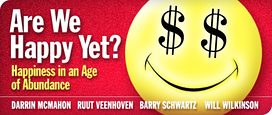In this post, Barry claims:
Even if well-being is trending up in the U.S., so too is clinical depression (including suicide).
I’m not sure that this is true in the case of depression, and I’m pretty sure it isn’t for suicide.
Estimates of the incidence of depression may be vastly overinflated due to a number of considerations laid out with great force by Jerome Wakefield and Allan Horwitz in this 2005 Public Interest article, and in their forthcoming book, The Loss of Sadness: How Psychiatry Transformed Normal Sorrow into Depressive Disorder. Reporting on a new study headed by Wakefield, the New York Times says:
About one in four people who appear to be depressed are in fact struggling with the normal mental fallout from a recent emotional blow, like a ruptured marriage, the loss of a job or the collapse of an investment, a new study suggests. To avoid unnecessary diagnoses and stigma, the standard definition of depression should be redrawn to specifically exclude such cases, the authors argue.
Moreover, there is a straightforward tension between the happiness data and data that appear to show a large increase in the incidence of depression: the percentage of people placing themselves in the lowest happiness category has either fallen or stayed stable (in the U.S., at least). If depression (or even normal, non-disordered sadness) is really rising rapidly, why isn’t the proportion of the population reporting low life satisfaction expanding?
Regarding suicide, the long-term trend appears rosy. The U.S. National Center for Health Statistics indicates [xls] that the number of suicides per 100,000 people was 13.2 in 1950 and 10.8 in 2003 in the United States. The suicide rate has never been worse than that since 1950. There are ups and downs through the 1960s and ’70s, but there’s a pretty steady downward trend from 1985 to 2000, in which year the suicide rate hit the lowest point in recent memory: 10.4 per 100,000 Americans. The rate increased to 10.9 by 2002, but was down a notch in 2003, the last year for which I have data. Unless there has been a big spike in the last few years, the worst we can say is that the suicide rate in 2003 was as bad as in any year since 1998 — which had a lower suicide rate than any of the previous 50 years. This is better than bad: it’s good!
Taken at face value, this result would seem to support the validity of the happiness measures, which show no increase in dissatisfaction, and undermine the validity of the depression measures, which you would expect to be positively rather than negatively correlated with suicide rates.
Good news!

